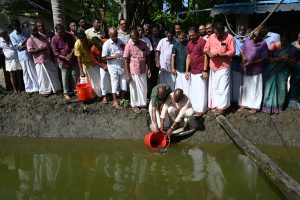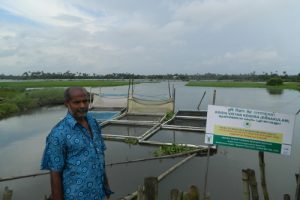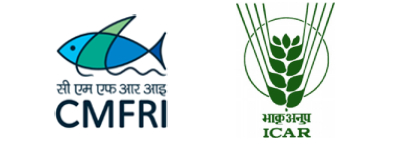Mr.Joseph Thakadiyil from Kothamangalam (Ph: 9446687191) was a traditional aqua farmer mainly doing small scale fresh water fish culture in his small ponds of 50 sent area. Due to lack of scientific practices, the venture was not given good income and slowly the ponds became abandoned. He was hardly earning INR35,000 from this venture annually. KVK formulated a package of practice for the small scale fish seed production using the portable carp hatchery system in his field and provided hands on training. Subsequently Catlacatla, Labeorohita and Cyprinuscarpio were bred in the portable carp hatchery system. He is presently producing 1,20,000 No. of fresh water fish seeds annually and earning INR 1,20,000 per year from this venture.
Mr.Ambrose Thommissery (Ph: 0484-2248638) was doing traditional shrimp farming in his 80 cent water body since 1998. Maximum profit ever realized for his venture was INR 48,000 during 1999. Thereafter a sum of Rs. 12000 per year was his average profit from the traditional shrimp farming from this area. KVK implemented a frontline demonstration on Scientific mullet farming in his field for 11 month period. Profit from the new programme was INR 2,00,000/-. The farmer deposited an amount of INR50,000/- from this profit towards the next years operational cost. This programme created a new avenue in the brackish water shrimp farming industry which is affected by virus disease on shrimps. It popularized the high value fin fish farming in place of shrimps. The programme also demonstrated a method for utilizing abandoned brackish water bodies.
Mr. Saigal a young farmer from Ezhikkara (Ph: 9846823043) was getting a profit of INR 50,000/- per ha from his pokkali fields where paddy and shrimp were alternatively grown. KVK demonstrated integration of Fin Fish Culture in cages also to his system.The objective of this programme was to increase total income per ha in pokkali fields. The fixed cost required for the cage culture in 1 ha pokkali fields is INR 88,200/-. Since the assets can be used for 5 years, the fixed cost per year would be INR 17,640/-. The operational cost per year is INR 90,000/-. The gross income per year Saibil got was INR 1,90,000/- and the profit per year was INR 83,000/- only from cage culture.
Mr. Shaji Varghees, Kottanakkottil (H), varapetty (PO)( Ph. 9446138345) was conventionally doing fish farming in his ponds of 0.2 ha area earning a profit of INR 5,000 annually.KVK demonstrated High density cage culture of Pearl spot (Karimeen) in his abandoned granite quarry. During a period of 10 months he produced 200 kg of fish. The investment per one season of 12 months was INR 30,000/-. The net income was INR65,000 leading to a profit of INR 36,900/- from three cages and BC ratio was 1.23. KVK could popularize this programme as an enterprise and the farming was in a business mode. He became KVK’s torch bearer in this technology and more farmers in the district are attracted by the initiative and have started to use their own quarries for fish culture ventures
Mr. Thomas from Ayoor village of Kunnukara (Ph. 9567434390) grama panchayath was a traditional rice farmer. KVK conducted a frontline demonstration in his field on System of Rice Intensification (SRI) method developed by International Rice Research Institute (IRRI), Phillippenes. Mr. Thomas has saved 30% labour by adopting this technology. Quantity of seed required for cropping was also drastically reduced. Normal transplanting required 30 to 40 Kg seed/ ha , but SRI required only 6 Kg seed thereby saving on the cost of seed. There is a saving of Rs. 1000/ ha for the cost of seeds, Rs.1000 for irrigation and 15 Nos of labour @ Rs.300/person. So a total of Rs. 5000 to 6000 is saved per hectare and the production was 27% higher than the normally transplanted rice crop. The additional per hectare yield of 7 quintal observed in SRI system in comparison with the normal system of transplanting provided an additional income of Rs.14,000.00 apart from the cost saving on labour, irrigation and seeds.




